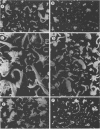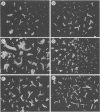Abstract
The effects of abscisic acid, zeatin, and gibberellic acid on the development of somatic embryos from cultured cells of caraway (Carum carvi L.) were observed.
Somatic embryos complete development on a basal medium without exogenous hormones, but some are subject to developmental abnormalities including malformed cotyledons and accessory embryos. Both zeatin and gibberellic acid, especially in combination, stimulate growth and increase the frequency of aberrant forms. Zeatin causes the formation of multiple shoots, leafy and abnormal cotyledons, and in the dark, enlarged hypocotyls; gibberellic acid effects root elongation, polycotyledony, and some callus formation. In contrast, abscisic acid, at concentrations which do not inhibit embryo maturation, selectively suppresses abnormal proliferations. With abscisic acid, and especially in the dark, a high percentage of embryos complete development with two fleshy cotyledons on unelongated axes free of accessory embryos.
In the light, zeatin eliminates abscisic acid inhibition while gibberellic acid only partially counters its effect, promoting elongated radicles and green rather than white cotyledons. In the dark, zeatin in combination with abscisic acid stimulates extensive callusing. Gibberellic acid does not reverse the effects of abscisic acid but rather enhances them and can counter the disruptive effects of zeatin.
The results demonstrate that the balance between abscisic acid on the one hand and zeatin and gibberellic acid on the other can effectively control somatic embryo development and either disrupt or ensure normal maturation.
Full text
PDF







Images in this article
Selected References
These references are in PubMed. This may not be the complete list of references from this article.
- Durley R. C., Bewley J. D., Railton I. D., Pharis R. P. Effects of Light, Abscisic Acid, and N-Benzyladenine on the Metabolism of [H]Gibberellin A(4) in Seeds and Seedlings of Lettuce, cv. Grand Rapids. Plant Physiol. 1976 May;57(5):699–703. doi: 10.1104/pp.57.5.699. [DOI] [PMC free article] [PubMed] [Google Scholar]
- Glinka Z. Abscisic Acid raises the permeability of plant cells to water. Plant Physiol. 1971 Jul;48(1):103–105. doi: 10.1104/pp.48.1.103. [DOI] [PMC free article] [PubMed] [Google Scholar]
- Raghavan V., Torrey J. G. Effects of Certain Growth Substances on the Growth and Morphogenesis of Immature Embryos of Capsella in Culture. Plant Physiol. 1964 Jul;39(4):691–699. doi: 10.1104/pp.39.4.691. [DOI] [PMC free article] [PubMed] [Google Scholar]
- Sankhla N., Sankhla D. Abscisin II-kinetin antagnoism in growth of Ipomea cotyledonary callus. Naturwissenschaften. 1968 Feb;55(2):91–92. doi: 10.1007/BF00599510. [DOI] [PubMed] [Google Scholar]
- Sussex I., Clutter M., Walbot V. Benzyladenine reversal of abscisic Acid inhibition of growth and RNA synthesis in germinating bean axes. Plant Physiol. 1975 Nov;56(5):575–578. doi: 10.1104/pp.56.5.575. [DOI] [PMC free article] [PubMed] [Google Scholar]





